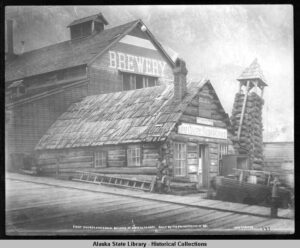- 1900
On June 4 Congress passed the Alaska Civil Code law and President William McKinley signed it into law two days later, which provided the incorporation of municipalities, so that Juneau, as well as other Alaska communities, could now have local self-government and could tax real property for the support of that government. The other provision made Juneau the “temporary seat of government” for the District of Alaska, with the headquarters to move here from Sitka as soon as suitable public buildings were provided. The district court judge and the U.S. Marshall and their assistants moved over to Juneau by the end of the year, but the full move was not to be realized until 1906 when newly-appointed Governor B. Wilford Hoggatt rented facilities in Juneau, packed up the office records at Sitka and had them transported to Juneau to make the transfer complete.
Upon hearing of the new law, a citizens committee immediately began circulating a petition for incorporation among Juneau’s electorate, which was rushed to Skagway to file with District Judge Melville Brown. He approved the petition for the incorporation of Juneau as a first class city and then set June 29, as the date for an election to approve the proposition and to elect a City Council of seven members and a School Board of three members. Incorporation was thereupon approved by the voters and a mayor, city council, and school board were duly elected and got down to the business of governing. On July 3 Judge Brown formally accepted the election results and Juneau became the first first-class home-rule city in Alaska, beating out Skagway, as the first city in Alaska with an organized municipal government. Former U. S. District Judge Arthur K. Delaney was Juneau’s first mayor, chosen in part for the large effort he made to get the city incorporated.
The Juneau Public School System was established when the newly-elected school board was sworn in July 14, giving Juneau the honor of having the first independent public school in Alaska. Increased enrollment and overcrowding was a first priority issue, so a second floor was added to the existing school building that summer. Financing was aided in part by the new civil code, which allowed incorporated municipalities to use up to fifty percent of the saloon and other business license taxes to support local schools.
The Last Chance Mining Co. began to build an enormous wooden flume nearly the length of the basin to carry the waters of Gold Creek while it mined the gravels of the basin, The first salmon canneries in the area were built at Sunny Cove in Taku Inlet and at Port Snettisham, neither of which ran more than several seasons, but set the stage for developing the local salmon canning industry.
June 16 The steamer Alert brought in the sad news of two deaths from mussel poisoning near Seward City on Lynn Canal. Four prospectors were camped on the beach there and gathered a batch of blue mussels for supper. All four became ill soon after they had eaten. Some whiskey was secured; two refused to touch a drop and died shortly afterwards, but the two that drank freely were reported to be recovering nicely.

City Brewery with its office in the first log cabin school and church building. Alaska State Library, Case and Draper Photograph Collection, P39-0048a.
June 20 The City Brewery went into operation with the starting up of its refrigeration plant. The firm was recently incorporated for $15,000 and it will have one of the largest payrolls in the city.
